MGT603 Systems Thinking: Assessment 2 - Rich Picture, CATWOE Report
VerifiedAdded on 2022/09/30
|9
|1788
|23
Report
AI Summary
This report presents an assessment of inventory management using a systems thinking approach. It begins with a rich picture diagram illustrating the current state of the inventory system and its reliance on the internet, highlighting customer interactions and potential issues. The report then employs the CATWOE analysis to delve deeper into the problems, examining the perspectives of customers, actors, transformation processes, world view, owner, and environmental constraints. The analysis identifies the importance of customer satisfaction and the need for efficient inventory management systems. Finally, the report offers recommendations to address identified issues, such as adjusting orders to meet customer demand, reducing manual processes, and improving information flow. The report references various academic sources to support its analysis and recommendations.

Running head: ASSESSMENT 2
Assessment 2
Name of the Student
Name of the University
Assessment 2
Name of the Student
Name of the University
Paraphrase This Document
Need a fresh take? Get an instant paraphrase of this document with our AI Paraphraser
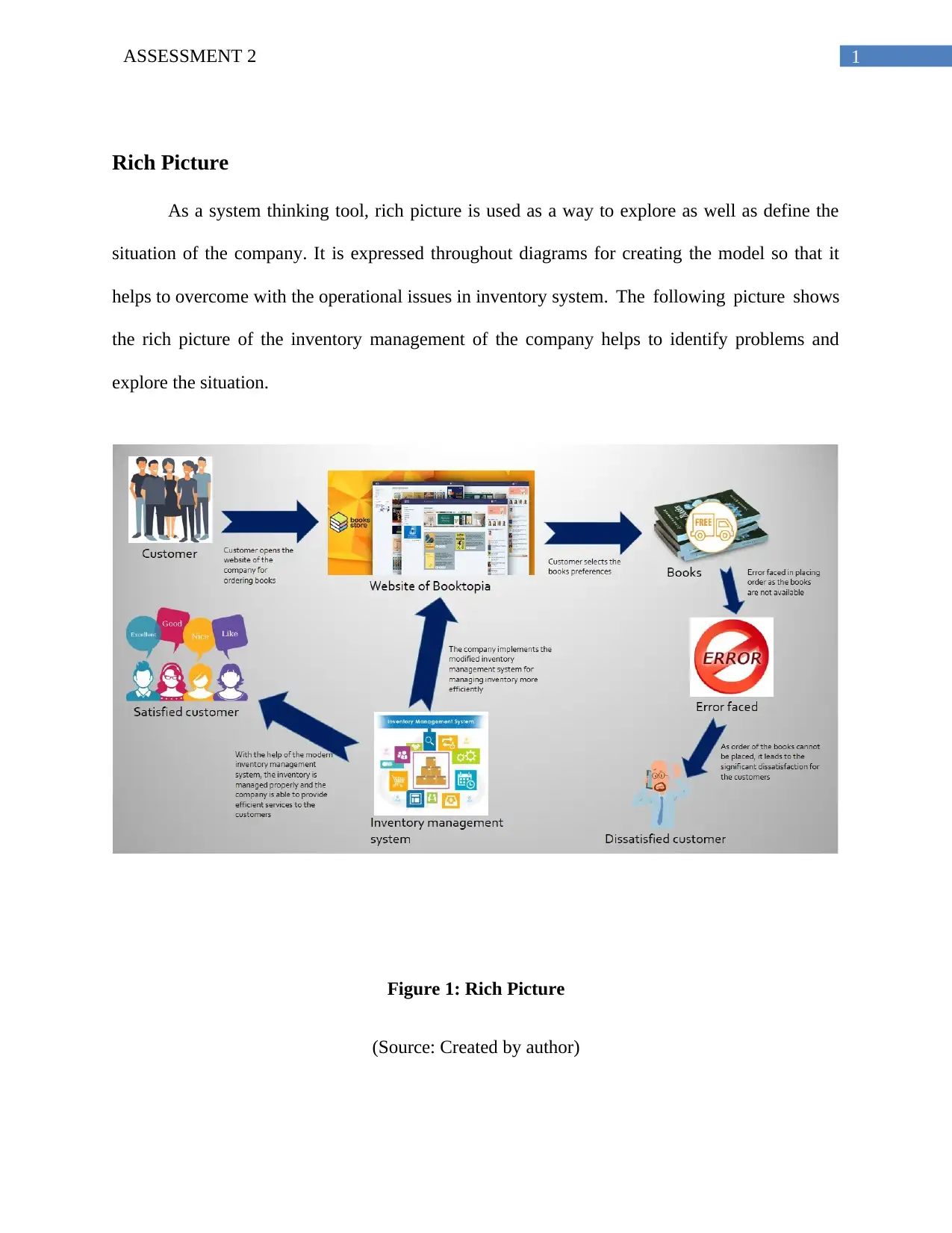
1ASSESSMENT 2
Rich Picture
As a system thinking tool, rich picture is used as a way to explore as well as define the
situation of the company. It is expressed throughout diagrams for creating the model so that it
helps to overcome with the operational issues in inventory system. The following picture shows
the rich picture of the inventory management of the company helps to identify problems and
explore the situation.
Figure 1: Rich Picture
(Source: Created by author)
Rich Picture
As a system thinking tool, rich picture is used as a way to explore as well as define the
situation of the company. It is expressed throughout diagrams for creating the model so that it
helps to overcome with the operational issues in inventory system. The following picture shows
the rich picture of the inventory management of the company helps to identify problems and
explore the situation.
Figure 1: Rich Picture
(Source: Created by author)
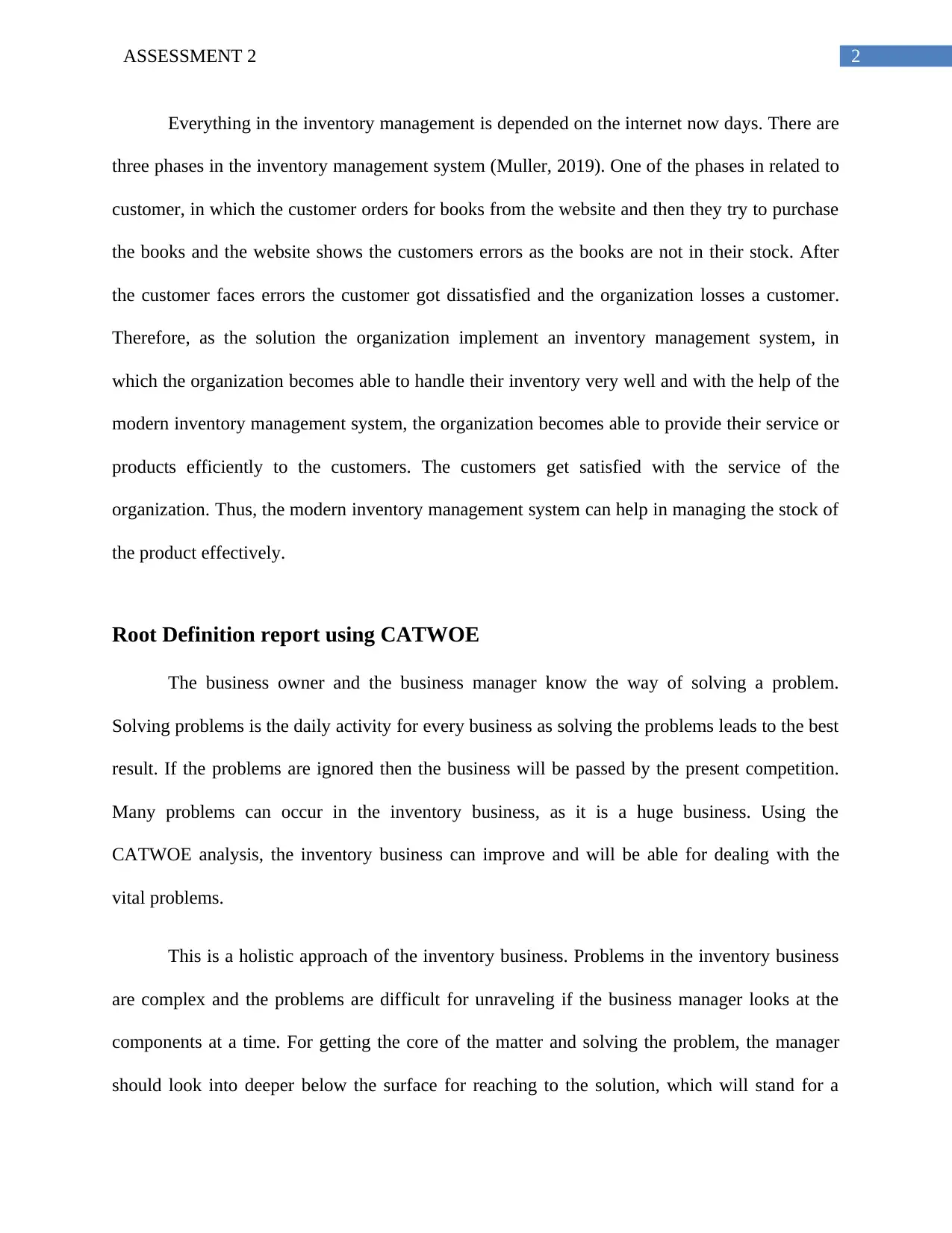
2ASSESSMENT 2
Everything in the inventory management is depended on the internet now days. There are
three phases in the inventory management system (Muller, 2019). One of the phases in related to
customer, in which the customer orders for books from the website and then they try to purchase
the books and the website shows the customers errors as the books are not in their stock. After
the customer faces errors the customer got dissatisfied and the organization losses a customer.
Therefore, as the solution the organization implement an inventory management system, in
which the organization becomes able to handle their inventory very well and with the help of the
modern inventory management system, the organization becomes able to provide their service or
products efficiently to the customers. The customers get satisfied with the service of the
organization. Thus, the modern inventory management system can help in managing the stock of
the product effectively.
Root Definition report using CATWOE
The business owner and the business manager know the way of solving a problem.
Solving problems is the daily activity for every business as solving the problems leads to the best
result. If the problems are ignored then the business will be passed by the present competition.
Many problems can occur in the inventory business, as it is a huge business. Using the
CATWOE analysis, the inventory business can improve and will be able for dealing with the
vital problems.
This is a holistic approach of the inventory business. Problems in the inventory business
are complex and the problems are difficult for unraveling if the business manager looks at the
components at a time. For getting the core of the matter and solving the problem, the manager
should look into deeper below the surface for reaching to the solution, which will stand for a
Everything in the inventory management is depended on the internet now days. There are
three phases in the inventory management system (Muller, 2019). One of the phases in related to
customer, in which the customer orders for books from the website and then they try to purchase
the books and the website shows the customers errors as the books are not in their stock. After
the customer faces errors the customer got dissatisfied and the organization losses a customer.
Therefore, as the solution the organization implement an inventory management system, in
which the organization becomes able to handle their inventory very well and with the help of the
modern inventory management system, the organization becomes able to provide their service or
products efficiently to the customers. The customers get satisfied with the service of the
organization. Thus, the modern inventory management system can help in managing the stock of
the product effectively.
Root Definition report using CATWOE
The business owner and the business manager know the way of solving a problem.
Solving problems is the daily activity for every business as solving the problems leads to the best
result. If the problems are ignored then the business will be passed by the present competition.
Many problems can occur in the inventory business, as it is a huge business. Using the
CATWOE analysis, the inventory business can improve and will be able for dealing with the
vital problems.
This is a holistic approach of the inventory business. Problems in the inventory business
are complex and the problems are difficult for unraveling if the business manager looks at the
components at a time. For getting the core of the matter and solving the problem, the manager
should look into deeper below the surface for reaching to the solution, which will stand for a
⊘ This is a preview!⊘
Do you want full access?
Subscribe today to unlock all pages.

Trusted by 1+ million students worldwide
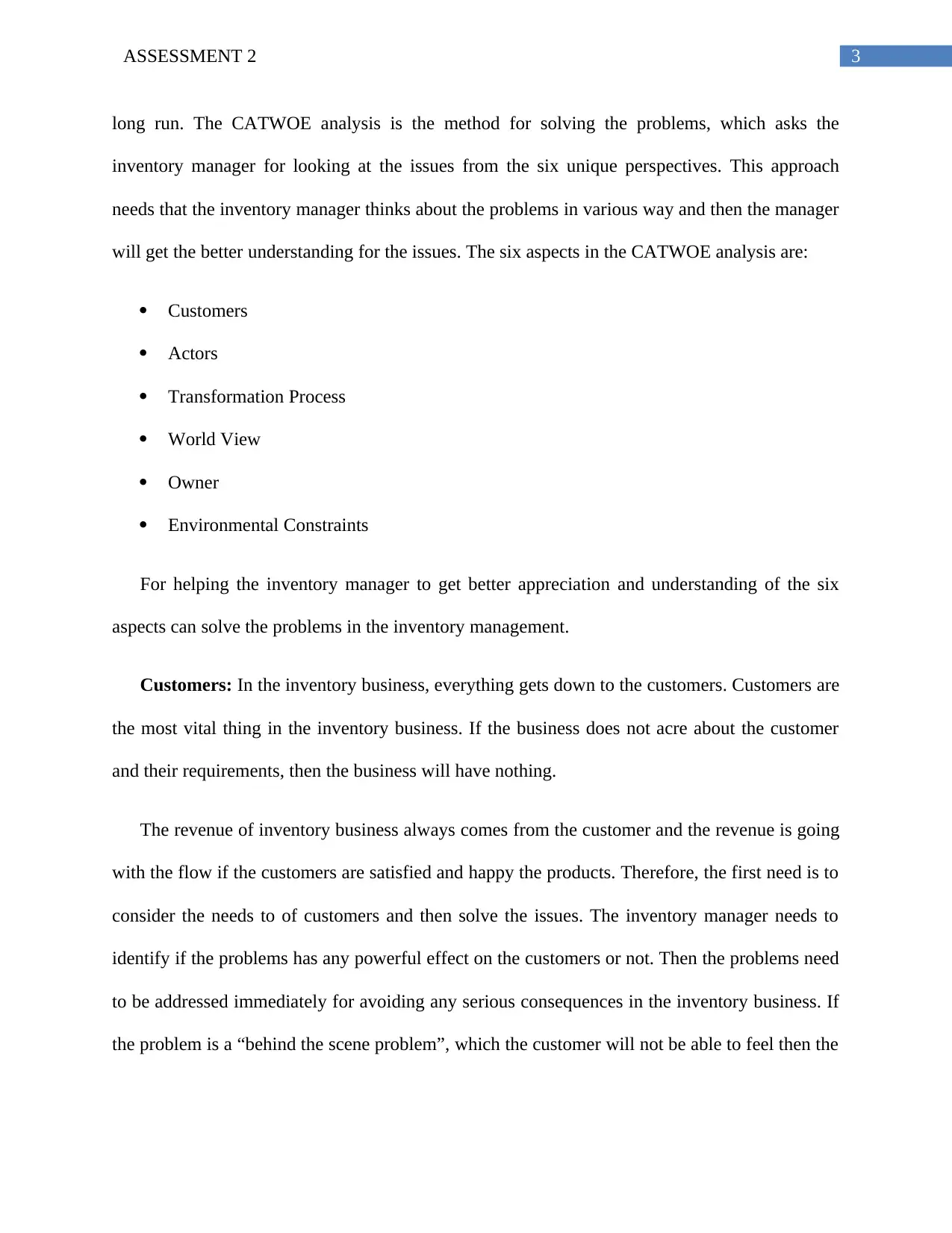
3ASSESSMENT 2
long run. The CATWOE analysis is the method for solving the problems, which asks the
inventory manager for looking at the issues from the six unique perspectives. This approach
needs that the inventory manager thinks about the problems in various way and then the manager
will get the better understanding for the issues. The six aspects in the CATWOE analysis are:
Customers
Actors
Transformation Process
World View
Owner
Environmental Constraints
For helping the inventory manager to get better appreciation and understanding of the six
aspects can solve the problems in the inventory management.
Customers: In the inventory business, everything gets down to the customers. Customers are
the most vital thing in the inventory business. If the business does not acre about the customer
and their requirements, then the business will have nothing.
The revenue of inventory business always comes from the customer and the revenue is going
with the flow if the customers are satisfied and happy the products. Therefore, the first need is to
consider the needs to of customers and then solve the issues. The inventory manager needs to
identify if the problems has any powerful effect on the customers or not. Then the problems need
to be addressed immediately for avoiding any serious consequences in the inventory business. If
the problem is a “behind the scene problem”, which the customer will not be able to feel then the
long run. The CATWOE analysis is the method for solving the problems, which asks the
inventory manager for looking at the issues from the six unique perspectives. This approach
needs that the inventory manager thinks about the problems in various way and then the manager
will get the better understanding for the issues. The six aspects in the CATWOE analysis are:
Customers
Actors
Transformation Process
World View
Owner
Environmental Constraints
For helping the inventory manager to get better appreciation and understanding of the six
aspects can solve the problems in the inventory management.
Customers: In the inventory business, everything gets down to the customers. Customers are
the most vital thing in the inventory business. If the business does not acre about the customer
and their requirements, then the business will have nothing.
The revenue of inventory business always comes from the customer and the revenue is going
with the flow if the customers are satisfied and happy the products. Therefore, the first need is to
consider the needs to of customers and then solve the issues. The inventory manager needs to
identify if the problems has any powerful effect on the customers or not. Then the problems need
to be addressed immediately for avoiding any serious consequences in the inventory business. If
the problem is a “behind the scene problem”, which the customer will not be able to feel then the
Paraphrase This Document
Need a fresh take? Get an instant paraphrase of this document with our AI Paraphraser
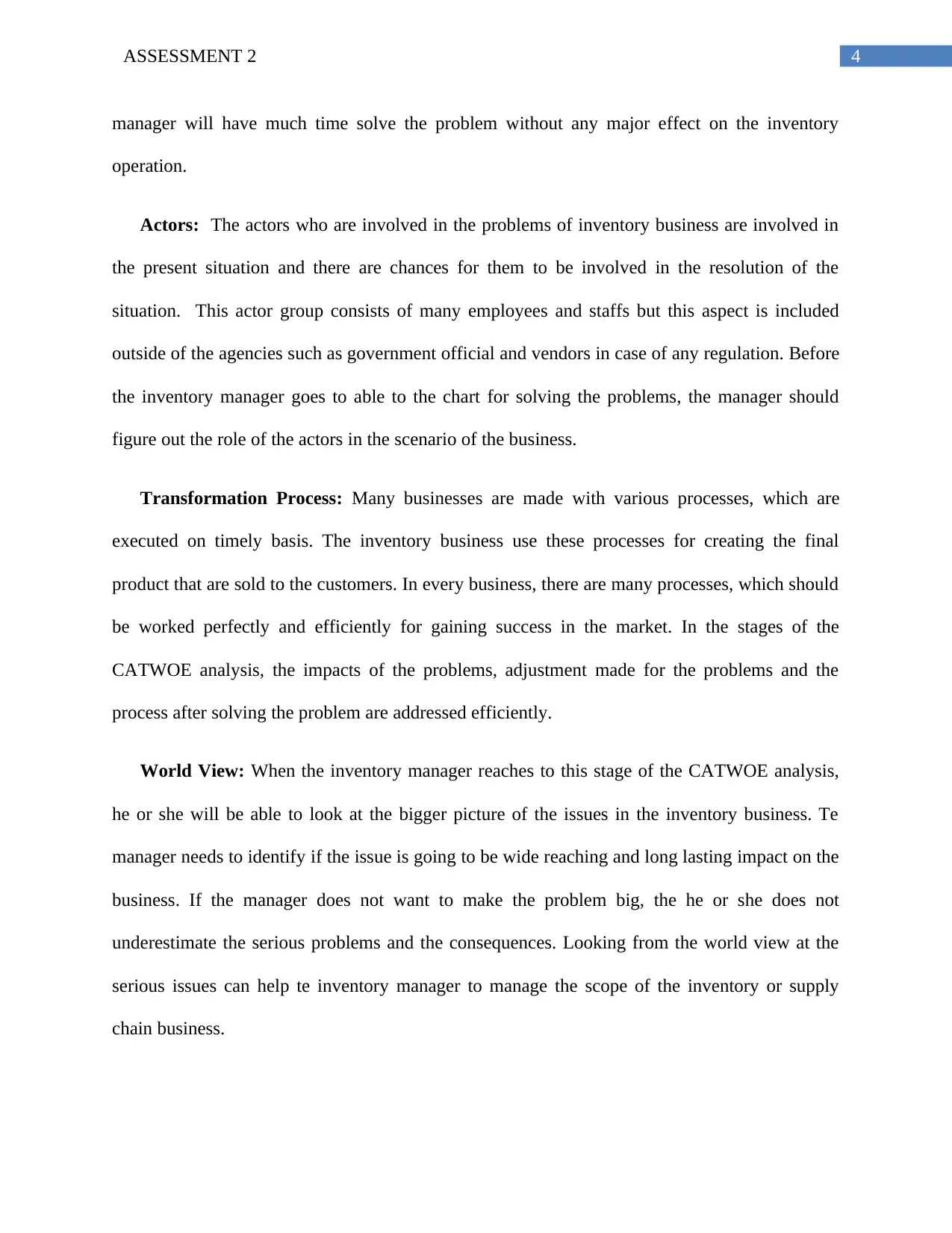
4ASSESSMENT 2
manager will have much time solve the problem without any major effect on the inventory
operation.
Actors: The actors who are involved in the problems of inventory business are involved in
the present situation and there are chances for them to be involved in the resolution of the
situation. This actor group consists of many employees and staffs but this aspect is included
outside of the agencies such as government official and vendors in case of any regulation. Before
the inventory manager goes to able to the chart for solving the problems, the manager should
figure out the role of the actors in the scenario of the business.
Transformation Process: Many businesses are made with various processes, which are
executed on timely basis. The inventory business use these processes for creating the final
product that are sold to the customers. In every business, there are many processes, which should
be worked perfectly and efficiently for gaining success in the market. In the stages of the
CATWOE analysis, the impacts of the problems, adjustment made for the problems and the
process after solving the problem are addressed efficiently.
World View: When the inventory manager reaches to this stage of the CATWOE analysis,
he or she will be able to look at the bigger picture of the issues in the inventory business. Te
manager needs to identify if the issue is going to be wide reaching and long lasting impact on the
business. If the manager does not want to make the problem big, the he or she does not
underestimate the serious problems and the consequences. Looking from the world view at the
serious issues can help te inventory manager to manage the scope of the inventory or supply
chain business.
manager will have much time solve the problem without any major effect on the inventory
operation.
Actors: The actors who are involved in the problems of inventory business are involved in
the present situation and there are chances for them to be involved in the resolution of the
situation. This actor group consists of many employees and staffs but this aspect is included
outside of the agencies such as government official and vendors in case of any regulation. Before
the inventory manager goes to able to the chart for solving the problems, the manager should
figure out the role of the actors in the scenario of the business.
Transformation Process: Many businesses are made with various processes, which are
executed on timely basis. The inventory business use these processes for creating the final
product that are sold to the customers. In every business, there are many processes, which should
be worked perfectly and efficiently for gaining success in the market. In the stages of the
CATWOE analysis, the impacts of the problems, adjustment made for the problems and the
process after solving the problem are addressed efficiently.
World View: When the inventory manager reaches to this stage of the CATWOE analysis,
he or she will be able to look at the bigger picture of the issues in the inventory business. Te
manager needs to identify if the issue is going to be wide reaching and long lasting impact on the
business. If the manager does not want to make the problem big, the he or she does not
underestimate the serious problems and the consequences. Looking from the world view at the
serious issues can help te inventory manager to manage the scope of the inventory or supply
chain business.
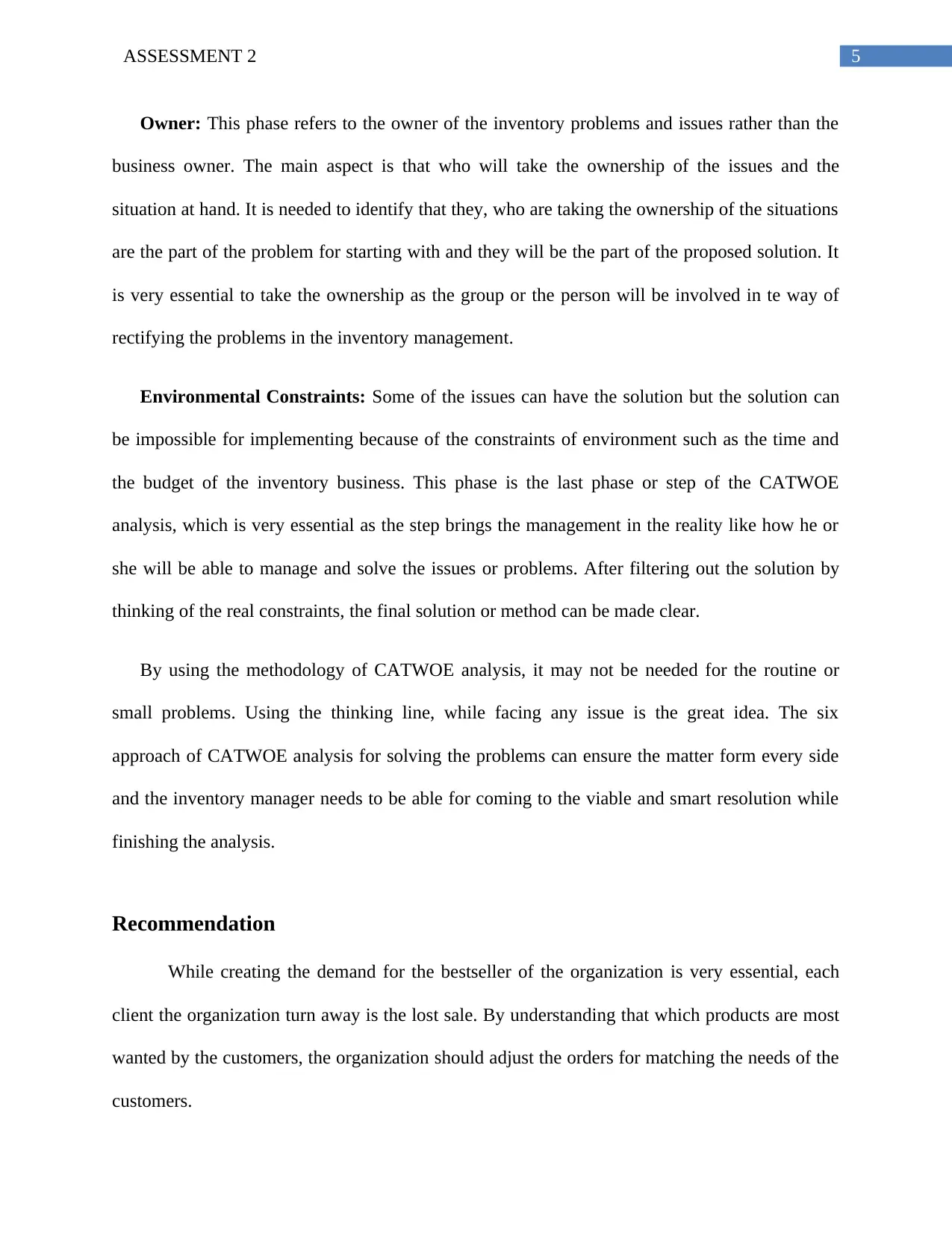
5ASSESSMENT 2
Owner: This phase refers to the owner of the inventory problems and issues rather than the
business owner. The main aspect is that who will take the ownership of the issues and the
situation at hand. It is needed to identify that they, who are taking the ownership of the situations
are the part of the problem for starting with and they will be the part of the proposed solution. It
is very essential to take the ownership as the group or the person will be involved in te way of
rectifying the problems in the inventory management.
Environmental Constraints: Some of the issues can have the solution but the solution can
be impossible for implementing because of the constraints of environment such as the time and
the budget of the inventory business. This phase is the last phase or step of the CATWOE
analysis, which is very essential as the step brings the management in the reality like how he or
she will be able to manage and solve the issues or problems. After filtering out the solution by
thinking of the real constraints, the final solution or method can be made clear.
By using the methodology of CATWOE analysis, it may not be needed for the routine or
small problems. Using the thinking line, while facing any issue is the great idea. The six
approach of CATWOE analysis for solving the problems can ensure the matter form every side
and the inventory manager needs to be able for coming to the viable and smart resolution while
finishing the analysis.
Recommendation
While creating the demand for the bestseller of the organization is very essential, each
client the organization turn away is the lost sale. By understanding that which products are most
wanted by the customers, the organization should adjust the orders for matching the needs of the
customers.
Owner: This phase refers to the owner of the inventory problems and issues rather than the
business owner. The main aspect is that who will take the ownership of the issues and the
situation at hand. It is needed to identify that they, who are taking the ownership of the situations
are the part of the problem for starting with and they will be the part of the proposed solution. It
is very essential to take the ownership as the group or the person will be involved in te way of
rectifying the problems in the inventory management.
Environmental Constraints: Some of the issues can have the solution but the solution can
be impossible for implementing because of the constraints of environment such as the time and
the budget of the inventory business. This phase is the last phase or step of the CATWOE
analysis, which is very essential as the step brings the management in the reality like how he or
she will be able to manage and solve the issues or problems. After filtering out the solution by
thinking of the real constraints, the final solution or method can be made clear.
By using the methodology of CATWOE analysis, it may not be needed for the routine or
small problems. Using the thinking line, while facing any issue is the great idea. The six
approach of CATWOE analysis for solving the problems can ensure the matter form every side
and the inventory manager needs to be able for coming to the viable and smart resolution while
finishing the analysis.
Recommendation
While creating the demand for the bestseller of the organization is very essential, each
client the organization turn away is the lost sale. By understanding that which products are most
wanted by the customers, the organization should adjust the orders for matching the needs of the
customers.
⊘ This is a preview!⊘
Do you want full access?
Subscribe today to unlock all pages.

Trusted by 1+ million students worldwide
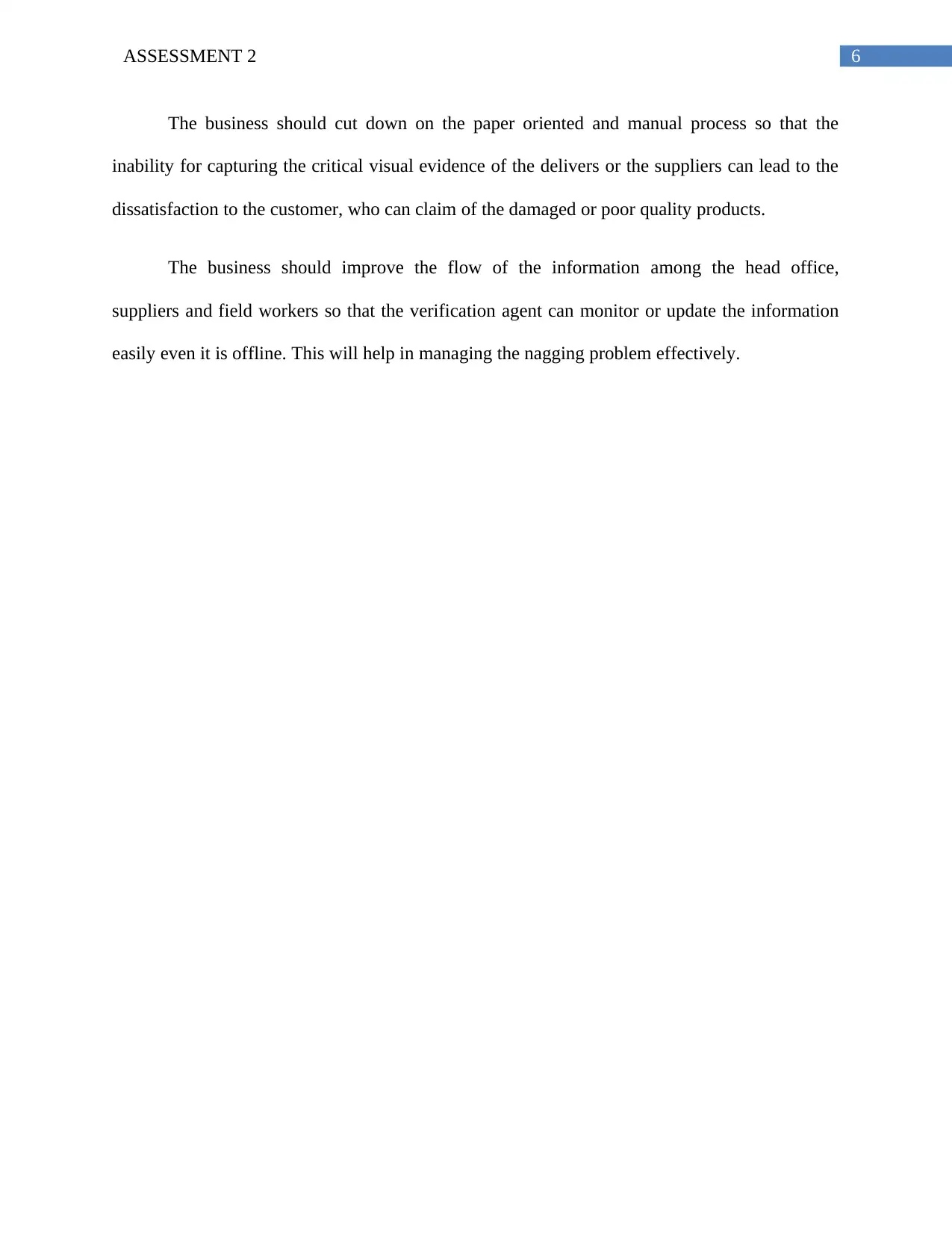
6ASSESSMENT 2
The business should cut down on the paper oriented and manual process so that the
inability for capturing the critical visual evidence of the delivers or the suppliers can lead to the
dissatisfaction to the customer, who can claim of the damaged or poor quality products.
The business should improve the flow of the information among the head office,
suppliers and field workers so that the verification agent can monitor or update the information
easily even it is offline. This will help in managing the nagging problem effectively.
The business should cut down on the paper oriented and manual process so that the
inability for capturing the critical visual evidence of the delivers or the suppliers can lead to the
dissatisfaction to the customer, who can claim of the damaged or poor quality products.
The business should improve the flow of the information among the head office,
suppliers and field workers so that the verification agent can monitor or update the information
easily even it is offline. This will help in managing the nagging problem effectively.
Paraphrase This Document
Need a fresh take? Get an instant paraphrase of this document with our AI Paraphraser
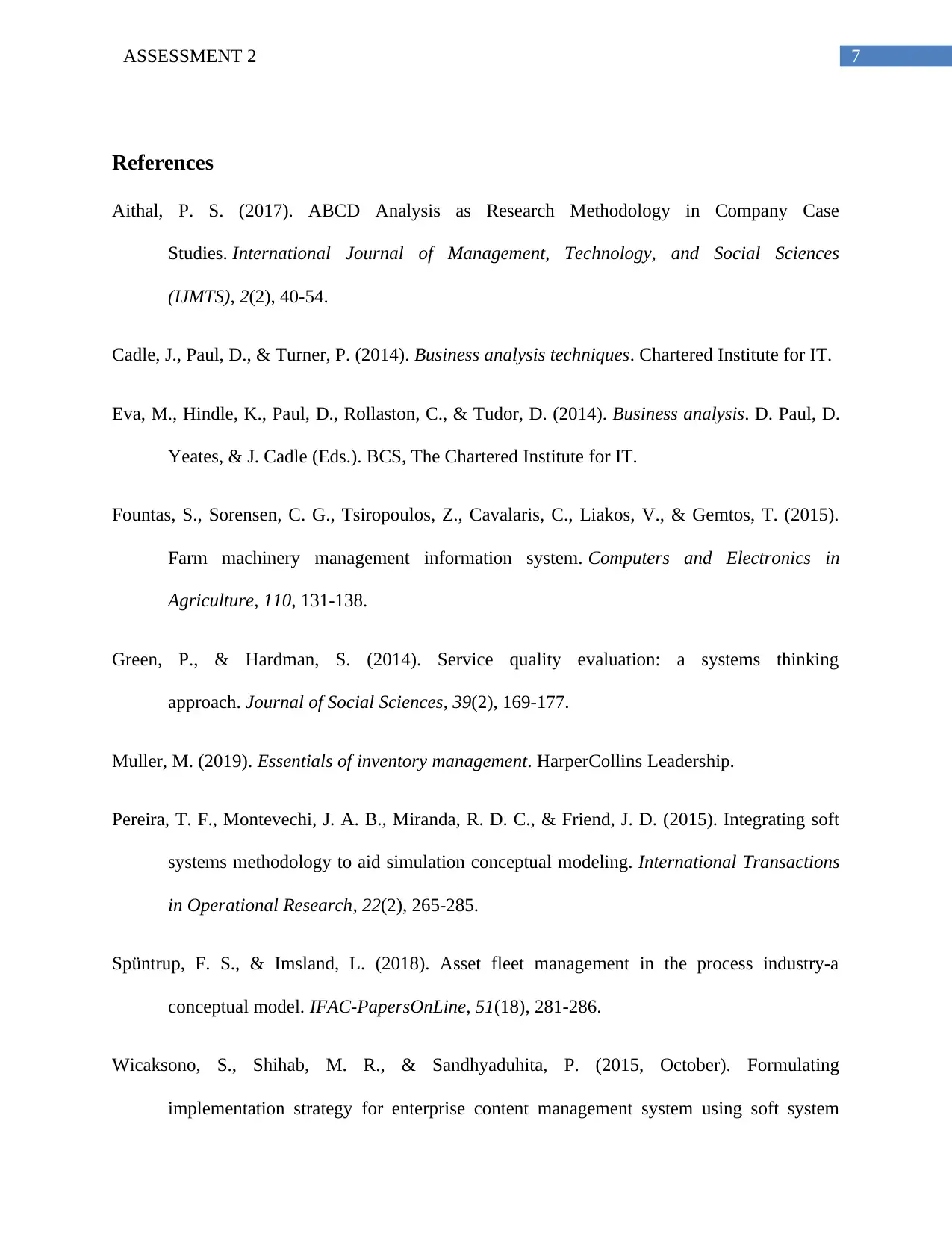
7ASSESSMENT 2
References
Aithal, P. S. (2017). ABCD Analysis as Research Methodology in Company Case
Studies. International Journal of Management, Technology, and Social Sciences
(IJMTS), 2(2), 40-54.
Cadle, J., Paul, D., & Turner, P. (2014). Business analysis techniques. Chartered Institute for IT.
Eva, M., Hindle, K., Paul, D., Rollaston, C., & Tudor, D. (2014). Business analysis. D. Paul, D.
Yeates, & J. Cadle (Eds.). BCS, The Chartered Institute for IT.
Fountas, S., Sorensen, C. G., Tsiropoulos, Z., Cavalaris, C., Liakos, V., & Gemtos, T. (2015).
Farm machinery management information system. Computers and Electronics in
Agriculture, 110, 131-138.
Green, P., & Hardman, S. (2014). Service quality evaluation: a systems thinking
approach. Journal of Social Sciences, 39(2), 169-177.
Muller, M. (2019). Essentials of inventory management. HarperCollins Leadership.
Pereira, T. F., Montevechi, J. A. B., Miranda, R. D. C., & Friend, J. D. (2015). Integrating soft
systems methodology to aid simulation conceptual modeling. International Transactions
in Operational Research, 22(2), 265-285.
Spüntrup, F. S., & Imsland, L. (2018). Asset fleet management in the process industry-a
conceptual model. IFAC-PapersOnLine, 51(18), 281-286.
Wicaksono, S., Shihab, M. R., & Sandhyaduhita, P. (2015, October). Formulating
implementation strategy for enterprise content management system using soft system
References
Aithal, P. S. (2017). ABCD Analysis as Research Methodology in Company Case
Studies. International Journal of Management, Technology, and Social Sciences
(IJMTS), 2(2), 40-54.
Cadle, J., Paul, D., & Turner, P. (2014). Business analysis techniques. Chartered Institute for IT.
Eva, M., Hindle, K., Paul, D., Rollaston, C., & Tudor, D. (2014). Business analysis. D. Paul, D.
Yeates, & J. Cadle (Eds.). BCS, The Chartered Institute for IT.
Fountas, S., Sorensen, C. G., Tsiropoulos, Z., Cavalaris, C., Liakos, V., & Gemtos, T. (2015).
Farm machinery management information system. Computers and Electronics in
Agriculture, 110, 131-138.
Green, P., & Hardman, S. (2014). Service quality evaluation: a systems thinking
approach. Journal of Social Sciences, 39(2), 169-177.
Muller, M. (2019). Essentials of inventory management. HarperCollins Leadership.
Pereira, T. F., Montevechi, J. A. B., Miranda, R. D. C., & Friend, J. D. (2015). Integrating soft
systems methodology to aid simulation conceptual modeling. International Transactions
in Operational Research, 22(2), 265-285.
Spüntrup, F. S., & Imsland, L. (2018). Asset fleet management in the process industry-a
conceptual model. IFAC-PapersOnLine, 51(18), 281-286.
Wicaksono, S., Shihab, M. R., & Sandhyaduhita, P. (2015, October). Formulating
implementation strategy for enterprise content management system using soft system
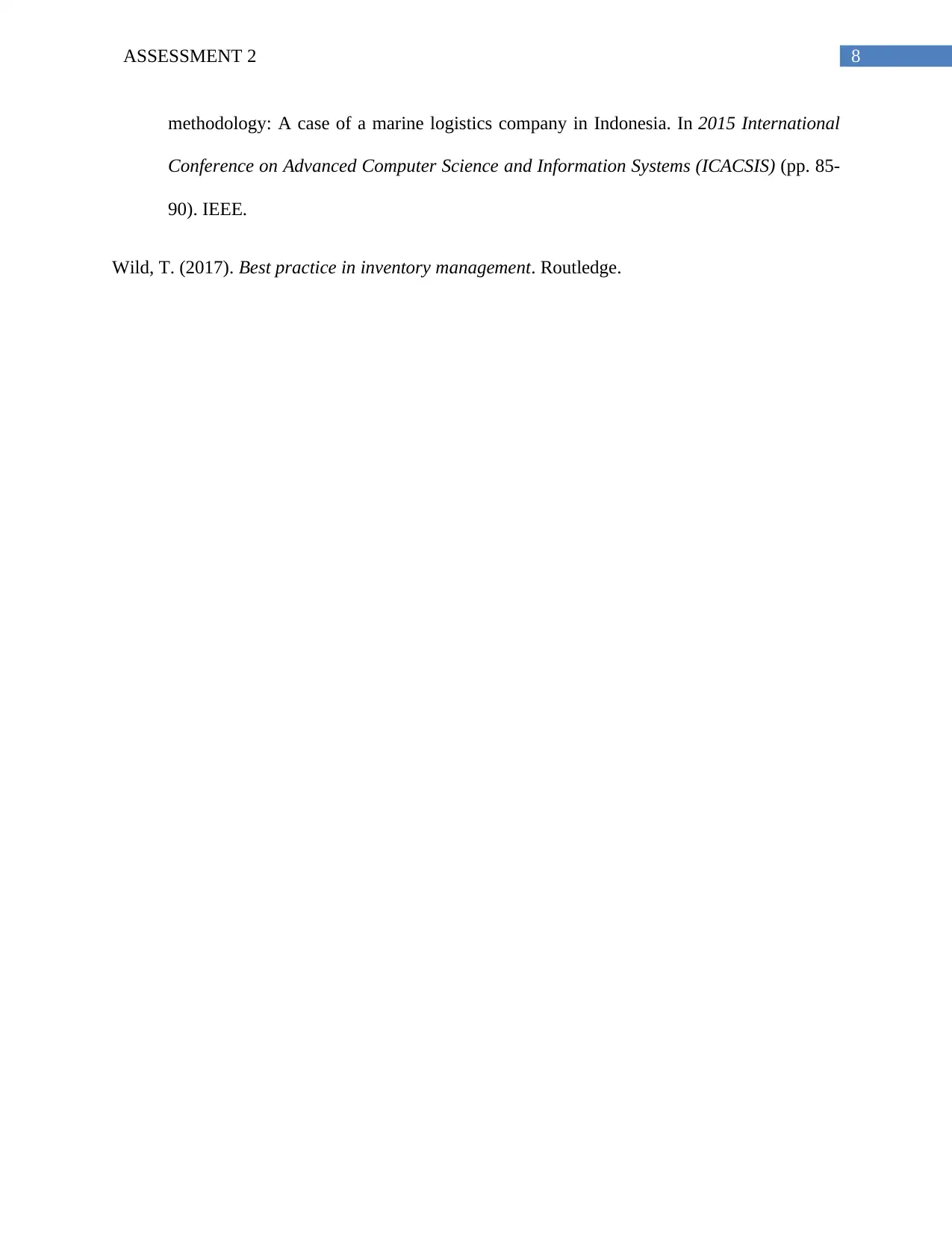
8ASSESSMENT 2
methodology: A case of a marine logistics company in Indonesia. In 2015 International
Conference on Advanced Computer Science and Information Systems (ICACSIS) (pp. 85-
90). IEEE.
Wild, T. (2017). Best practice in inventory management. Routledge.
methodology: A case of a marine logistics company in Indonesia. In 2015 International
Conference on Advanced Computer Science and Information Systems (ICACSIS) (pp. 85-
90). IEEE.
Wild, T. (2017). Best practice in inventory management. Routledge.
⊘ This is a preview!⊘
Do you want full access?
Subscribe today to unlock all pages.

Trusted by 1+ million students worldwide
1 out of 9
Related Documents
Your All-in-One AI-Powered Toolkit for Academic Success.
+13062052269
info@desklib.com
Available 24*7 on WhatsApp / Email
![[object Object]](/_next/static/media/star-bottom.7253800d.svg)
Unlock your academic potential
Copyright © 2020–2025 A2Z Services. All Rights Reserved. Developed and managed by ZUCOL.



